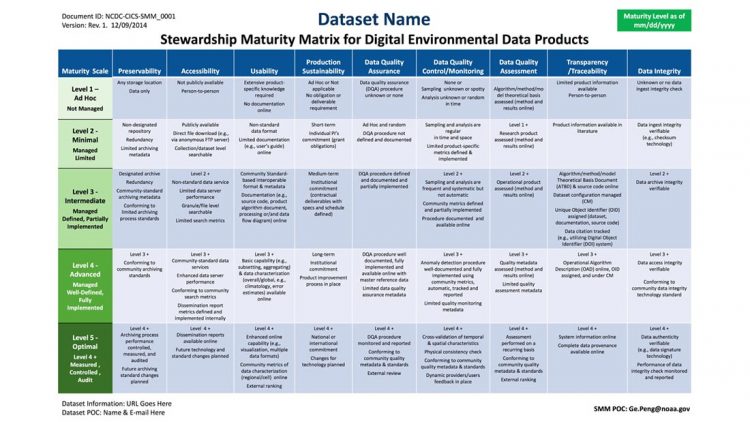
The stewardship maturity matrix template as presented in Peng et al. (2015). A digital version of the template will be made available at http://figshare.com/articles/NCDC_CICSNC_SDSMM_Template/1211954.
Collecting, curating, and delivering accurate, reliable environmental data sets is a difficult task. But the work doesn’t stop there. Ensuring that data sets are adequately preserved and documented, and that they remain accessible and usable to end users, is an ongoing challenge. In addition, the usefulness of these data sets also depends in large part on the ability of data providers and stewards to assess, demonstrate, and describe the quality of the information, and their ability to adopt community best practices and standards.
To address these data stewardship challenges, Dr. Ge Peng of the Cooperative Institute for Climate and Satellites–North Carolina and Jeffrey Privette, Edward Kearns, Nancy Ritchey, and Steve Ansari of the National Oceanic and Atmospheric Administration’s National Centers for Environmental Information, have developed a new “stewardship maturity matrix.” They describe this new model—a unified framework for assessing stewardship practices applied to individual digital climate datasets—in a new paper in Data Science Journal.1 Their work leverages recommendations from bodies of experts as well as institutional knowledge, and builds on community best practices and standards.
The stewardship model specifies nine data stewardship attributes: preservability, accessibility, usability, production sustainability, data quality assurance, data quality control/monitoring, data quality assessment, transparency/traceability, and data integrity. Measureable stewardship practices under each attribute are evaluated using a progressive five-level maturity scale. This progressive structure provides a road map that data stewards can use to assess and improve their data stewardship practices, and the resulting maturity matrix in turn allows data users to evaluate the appropriateness of a data set for their requirements.
Although the development of the stewardship maturity matrix was motivated by the needs of the Earth Sciences data community, the model is intended to be general enough to be used with a wide variety of digital environmental data products and a broad spectrum of users.
Peng, G., J. L. Privette, E. J. Kearns, N. A. Ritchey, and S. Ansari, 2015: A unified framework for measuring stewardship practices applied to digital environmental datasets. Data Science Journal, 13, 231-253, doi:10.2481/dsj.14-049. [Available online at https://http://www.jstage.jst.go.jp/article/dsj/13/0/13_14-049/_pdf]
